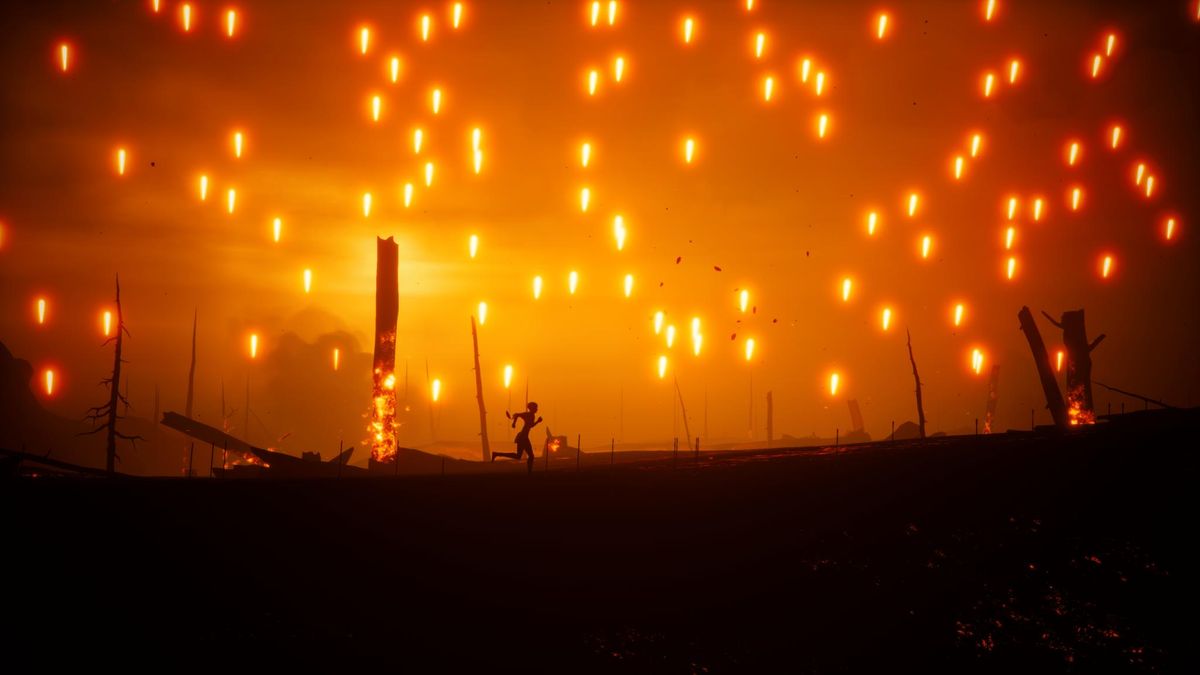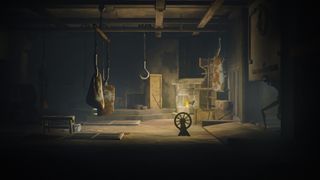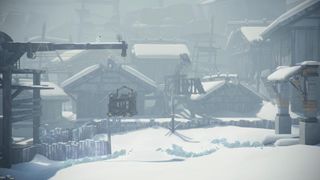STELA for Apple Arcade Review: The Perils of Polygonal Pauline

At the beginning of Apple Arcade's STELA, your heroine wakes up in a dank cavern. This is basically the best thing that will happen to her for the rest of the game.
She's wearing what looks like athleisure wear and a translucent half-cape, which, while certainly appropriate for all the cardio she'll be doing, seems wildly impractical for the hellish apocalypse she's about to jog through. But hey, considering the mind-boggling number of things that will almost immediately and then continuously attempt to kill her, she might as well look fashionable while she's dying over and over and over again.
Skybox Labs' STELA is basically a ripoff, at least in style, tone, and gameplay, of Playdead's acclaimed and creepy Inside. You've got haunting, decaying surroundings, a side-scrolling platformer enhanced by clever use of a moving, cinematic camera, lots of hiding from shadowy perils, and an enigmatic storyline that lets your imagination do all the heavy lifting. But while Inside won plaudits as a challenging and unsettling experience, STELA mainly just wants to aspire to artsy pretension, have a good time, and look pretty doing it. It clears that considerably lower bar with ease.

Unlimited games, one price
Apple Arcade has over a hundred premium games with more added regularly each week. There is something here for everyone, and it only costs $5 a month for all you can game!
Run fast, die often, and leave a well-dressed corpse

Many things in STELA are not, and never become, clear: What messed up the world you're in? (Giant cornstalks next to an equally immense barn suggest genetic engineering run amok may have contributed.) What are those long-limbed shadow-beasties who won't stop chasing you? Who's firing all those flaming arrows at you in one level, and is there any chance they might give it a rest? (No.) What kind of architect puts a rotating spike-wheel in an underground tomb, seriously? And where are you headed, aside from "always toward the right side of the screen"?
Your heroine can run, jump, climb, and occasionally interact with objects in various ways. She can also die, a lot, and she will. The gameplay mostly involves enduring countless horrible mangling deaths until you figure out what you were doing wrong and manage to press buttons at the right time to not do that thing. But every so often, you'll also find some split-second moment when you take an impulsive, intuitive action, completely stick the landing, and feel like a super-cool action hero doing it.
The sheer variety and frequency of ways to die in STELA starts out stressful but rapidly grows almost comedic. Your character just never, ever catches a break, in ways that may leave you chortling affectionately at the game's insistence on your violent demise. Oh, thank goodness! You've finally escaped from the underground ziggurat packed with completely unnecessary deathtraps. Welp, time for the immense tentacles of some Lovecraftian horror to emerge from the darkness and try to make an hors d'oeurve of you!
"Oh, game," you'll chuckle, shaking your head, "there you go trying to murder me again." STELA's achievements, which pop up with droll, deliberately understated synopses of whatever nightmare you've just narrowly escaped, suggest that the designers may well be in on the joke.
Master your iPhone in minutes
iMore offers spot-on advice and guidance from our team of experts, with decades of Apple device experience to lean on. Learn more with iMore!
Maybe an inch deep, but oh so pretty

STELA's world looks undeniably gorgeous, whether you're creeping through fog-shrouded forests, racing from snow-burrowing seal-monsters on a frozen tundra, or, well, whatever the heck is going on in the game's admirably bananas final levels. (At the end, the designers turn the weirdness knob up so hard, and so fast, that it seems to have snapped off in their hands.) In its use of hazy light and earth-toned colors, I kept recalling Roger Deakins's stunning cinematography for Blade Runner 2049.
The game makes excellent use of its roving camera, which dynamically pulls out to capture the bleak beauty of a particular vista, or zooms in to help you figure out your latest survival-imperative challenge. Things skulking in the foreground or background help add atmosphere and tension. Puzzles aren't too tough, still feel fun and satisfying to solve, and mostly involve practical considerations such as "figure out how to not get eaten by the thing that's coming to eat you." And the eerie, synth-y music strikes just the right futuristic chords.
But if you're looking for profundity, or coherence, or really even any kind of story at all, you've come to the wrong game. Things happen, and then other things happen, and then some other things happen, and none of it ever makes sense on anything more than a dream-logic level, but all of it looks super cool. I'm okay with that. Likely you will be, too.
Yet another (probably unintended) example of this game's sadism
You will probably not be okay with the game's touch controls, which are – how do I put this delicately? – hot garbage. The game offers no tutorial or explanation for how to control it, but it really, really should. I could not for the life of me figure out which corner of the screen I needed to swipe or tap or whatever to make the protagonist interact with her environment. Even though I could see the suspiciously glimmering cabinet I was supposed to pull down to block the oncoming horde of beetles that was chasing me, I couldn't ever actually do the thing, and thus got repeatedly devoured by ravenous insects a whole three minutes into the game.
My poor iPad did not deserve the abuse it endured over that. Spare your hardware and make sure you're playing this one on a computer or with a gamepad, where at least there are buttons you can try, knowing that you'll quickly find the one assigned to "do stuff so bugs don't consume you."
As long as you're avoiding the touch controls, STELA will keep you entertained for the few hours it takes to run all the way, at last, to the right side of the screen. What it lacks in originality, it makes up for in sheer malicious verve, and figuring out how to outwit the game's attempts to destroy you proves lots and lots of fun. The ending somehow manages to feel satisfying even as it utterly fails to make sense or provide a resolution.
You probably won't ever want or need to play STELA again once you've finished it. But if you're anything like me, you won't regret the time you spent, or the many, many, many lives you lost, in doing so.

Nathan Alderman is an iMore contributor. He’s been using Apple computers since his first Apple IIe in 1985, and writing professionally about Macs and their software since 2005. During his 12 years freelancing for Macworld, he covered email clients, web browsers, web design programs, writing apps, and games, and he’s continued to follow those interests at iMore since 2017. An editor and writing coach in his full-time career, he spends his dwindling spare time writing fiction for fun, volunteering for democracy, and contributing to podcasts on The Incomparable Network. Nathan adores his wife and wrangles his alarmingly large children in bucolic Crozet, VA.











